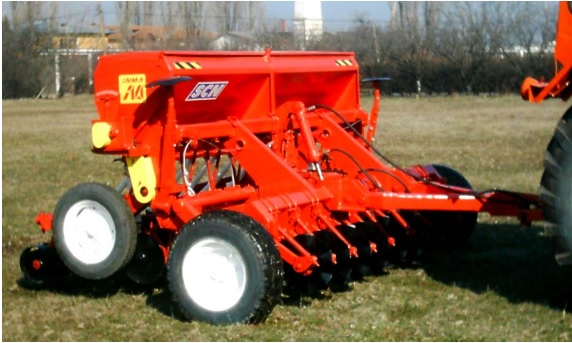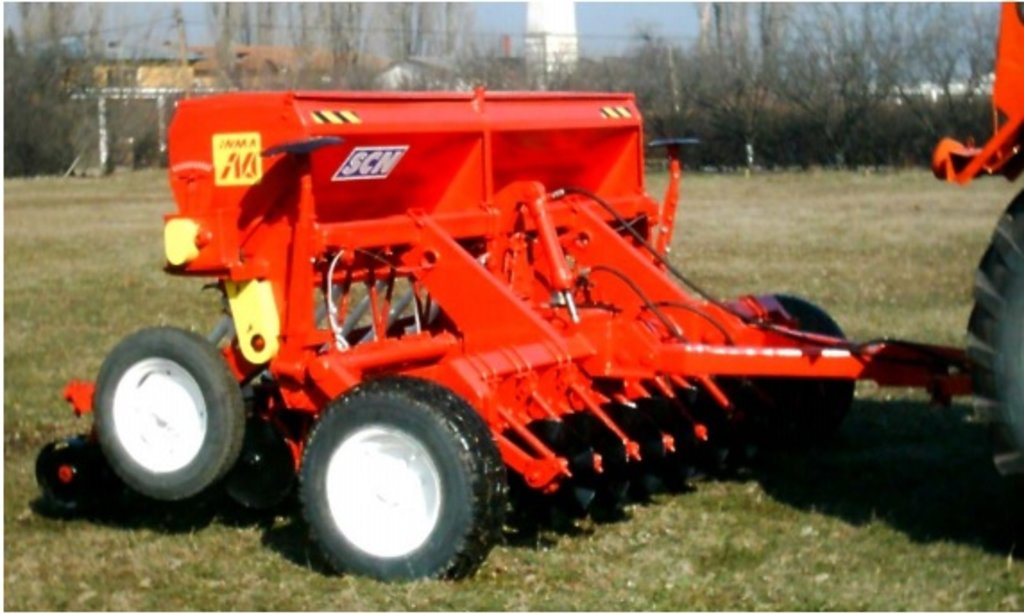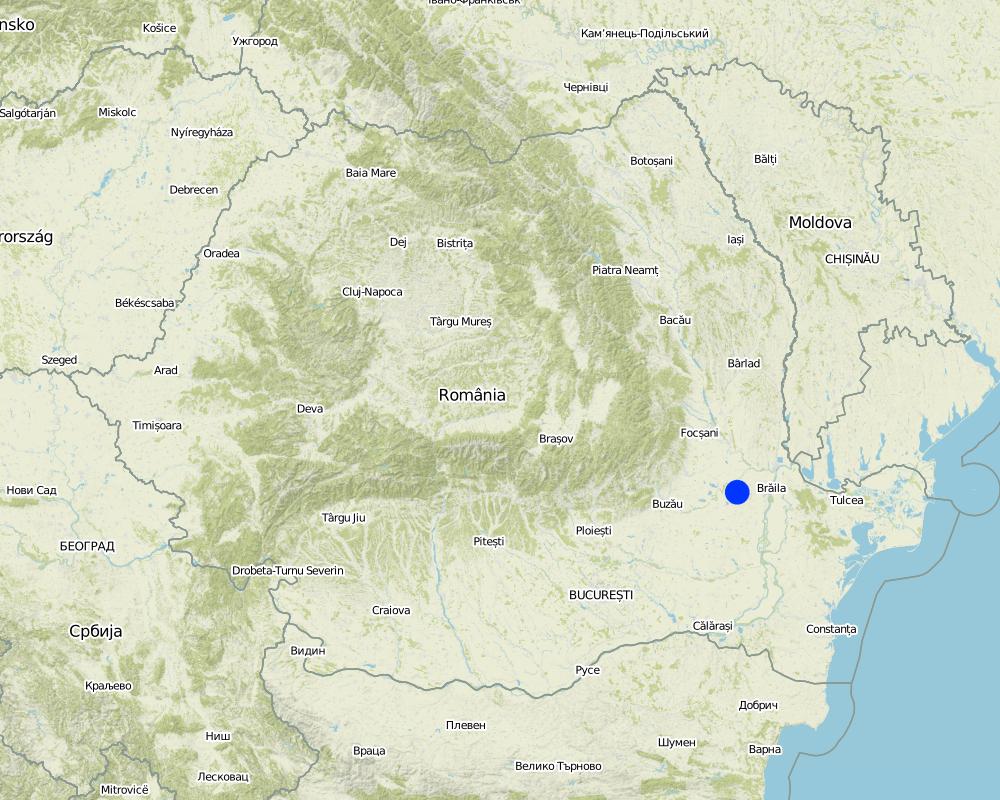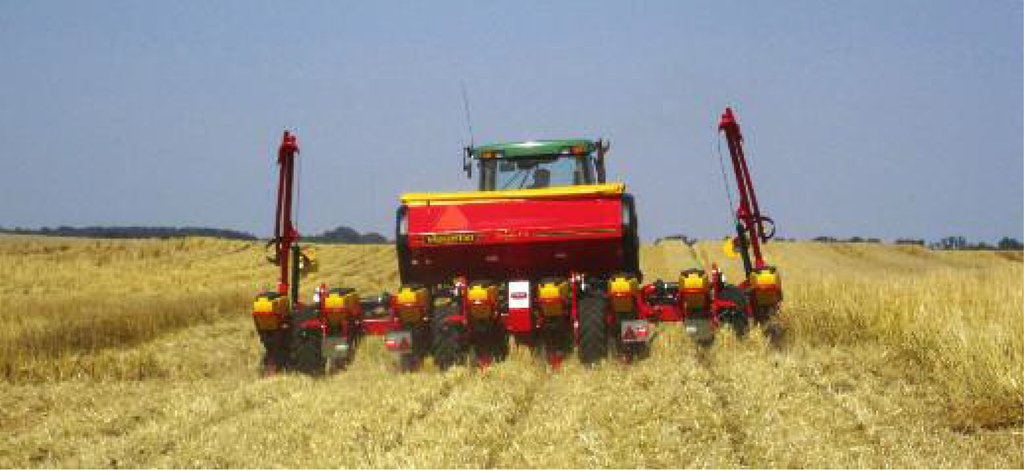Direct drill (no-till) for arable cropping systems [رومانيا]
- تاريخ الإنشاء:
- تحديث:
- جامع المعلومات: Olga Vizitiu
- المحرر: –
- المراجعون: Ursula Gaemperli, Gudrun Schwilch, Nina Lauterburg
technologies_2957 - رومانيا
عرض الأقسام
توسيع الكل طي الكل1. معلومات عامة
1.2 تفاصيل الاتصال بالأشخاص الرئيسيين لمصدر المعلومات والمؤسسات المشاركة في تقييم وتوثيق التقنية
اسم المشروع الذي سهّل توثيق/تقييم التقنية (إذا كان ذلك على صلة)
Interactive Soil Quality assessment in Europe and China for Agricultural productivity and Environmental Resilience (EU-iSQAPER)اسم المؤسسة (المؤسسات) التي سهلت توثيق/تقييم التقنية (إذا كان ذلك على صلة)
National Research and Development Institute for So (National Research and Development Institute for So) - رومانيا1.3 الشروط المتعلقة باستخدام البيانات الموثقة من خلال WOCAT
متى تم تجميع البيانات (ميدانيا)؟:
29/09/2017
يوافق جامع المعلومات والشخص (لاشخاص) الرئيسي لمصدر المعلومات على الشروط المتعلقة باستخدام البيانات الموثقة من خلال WOCAT:
نعم
1.4 إعلان بشأن استدامة التقنية الموصوفة
هل التقنية الموصوفة هنا تمثل مشكلة فيما يتعلق بتدهور الأراضي، بحيث لا يمكن إعلانها تقنية مستدامة لإدارة الأراضي؟:
كلا
2. وصف تقنيةالإدارة المستدامي للأراضي
2.1 وصف مختصر للتقنية
تعريف التقنية:
Direct drill (no-till) for arable cropping systems. Crop establishment with minimum soil disturbance.
2.2 وصف تفصيلي للتقنية
الوصف:
The technology is applied in Braila region and is located in north-eastern part of Romanian Plain. It has an agricultural area of 387,646 ha (of which 350,001 ha are arable land), and has specific geomorphologic, hydrological and climatic conditions which need to use ameliorative agricultural systems. Within Braila County are distinguished the following relief units: Calmatui Plain, part of the Braila Plain (51% from County area) and the Floodplains of Danube (Big Island of Braila), Siret, Buzau and Calmatui rivers (49% from County area).
Braila Plain is characterized by a specific micro-relief of Baragan type with large floodplains, poorly fragmented, with altitudes ranging between 20-25 m in the east part and 35-40 m to the west part, with soils mainly of chernozem type, formed on loess and loess deposits and which shows numerous small depression areas. Floodplains, areas adjacent to Danube, Siret, Buzau and Calmatui rivers are located at lower altitudes, ranging between 2-4 m and 13-15 m and are characterized by the presence of alluvial soils formed on river-limnic and alluvial deposits, with alternating of layers with different textures. According to United Nations Convention to Combat Desertification, Braila County is located in arid region with an average annual temperature of 10.9°C, long-term average annual precipitations (P) of 447 mm, potential evapotranspiration (ETP) of 705 mm (750-800 mm in dry years) and an average climatic water deficit of 258 mm (350-400 mm in dry years). The biophysical aridity index (P/ETP = 0.50-0.65) places the Braila region in area with moderate risk to desertification. Both intensive and extensive farming systems are practiced within Braila County. Intensive agriculture, characterized by high inputs and yield levels, is realized on large vegetal farms. On the other hand, extensive agriculture, with low input and yield levels, is practiced by farmers on small vegetal farms, and is so-called the semi-subsistent agriculture.
The direct drill (no-till) conservative tillage technology is an agronomic measure. It is practiced on medium to large size farms (from around 50 ha to more than 1000 ha) within the North-Eastern part of the Romanian Plain. Over the past years some farmers have changed their farming system from conventional to conservative. The main element of the technology is that the farmers use special agricultural machinery for direct seeding, and other tillage operations from conventional system, such as ploughing and disking, are not performed anymore. Also, under no-till farming system, the soil surface remains covered on 30% with plant residues from the pre-emergent crop.
The main purpose of the technology is to mitigate soil structure degradation due to less tillage passes on the land. The technology is applied on arable land with annual crops. The farmers have begun to adopt this technology due to reduction in fuel consumption and working hours. For this reason, the technology has economic advantages. The no-tillage system requires a special direct seeding machine, and this can be expensive. So, most of the farmers don't buy it on their own, but they rent the seeding machine from other farmers.
In the land user's view, the strengths of the technology are as follows: reduced fuel consumption, improved soil water regime and tillage of larger field areas with less personnel and less trafficability and workability. In addition, the weaknesses of the technology reported by the land user might be: difficulties in weeds and pests control due to spread of straw-borne diseases which can be countered by in-depth knowledge of biocides, and high investment costs for equipment purchase which can be met by application for non-reimbursable funds or renting the equipment from other farmers or agricultural contractors.
2.3 صور التقنية
2.5 البلد/المنطقة/المواقع التي تم تنفيذ التقنية فيها والتي يغطيها هذا التقييم
البلد:
رومانيا
المنطقة/الولاية/المحافظة:
Braila
مزيد من التفاصيل حول الموقع:
Braila
Map
×2.6 تاريخ التنفيذ
في حالة عدم معرفة السنة بالتحديد، يرجى الإشارة إلى التاريخ التقريبي:
- منذ 10-50 سنة
2.7 إدخال التقنية
حدد كيف تم إدخال التقنية:
- أثناء التجارب/الأبحاث
التعليقات (نوع المشروع، الخ):
The technology was firstly implemented in the early 2000's and described by the Agricultural Research and Development Station of Braila (ARDS Braila) which is subordinated to the Academy of Agricultural and Forestry Sciences. The station ARDS Braila conducts research and development in the following subjects: irrigation systems, agricultural technologies and improvement and reclamation of salted soils.
3. تصنيف تقنية الإدارة المستدامي للأراضي
3.1 الغرض الرئيسي ( الأغراض الرئيسية) للتقنية
- الحد من تدهور الأراضي ومنعه وعكسه
- الحفاظ على/تحسين التنوع البيولوجي
- التكيف مع تغير المناخ/الظواهر المتطرفة وآثارها
3.2 نوع (أنواع) استخدام الأراضي الحالية حيث يتم تطبيق التقنية

الأراضي الزراعية
- زراعة سنوية
المحاصيل الرئيسية (المحاصيل النقدية والغذائية):
winter wheat, winter barley, spring barley, maize
3.3 مزيد من المعلومات حول استخدام الأراضي
إمدادات المياه للأرض التي يتم تنفيذ التقنية عليها:
- مختلط بعلي-مروي
عدد مواسم الزراعة في السنة:
- 1
3.4 مجموعةالإدارة المستدامة للأراضي التي تنتمي إليها هذه التقنية
- الحد الأدنى من اختلال التربة
3.5 انتشار التقنية
حدد انتشار التقنية:
- منتشرة بالتساوي على مساحة
إذا كانت التقنية منتشرة بالتساوي على منطقة ما، فحدد المنطقة التقريبية المغطاة:
- < 0.1 كم2 (10 هكتار)
التعليقات:
Documentation of the technology is based on examination of field plots smaller than 0.1 km2.
3.6 التدابير التقنية في مجال إلادارة المستدامة للأراضي

التدابير الزراعية
- A3: معالجة سطح التربة
3.7 الأنواع الرئيسية من تدهور الأراضي التي تناولتها التقنية

التدهور المادي أو الفيزيائي للتربة
- (Pc) : تراص التربة
3.8 منع أو حد أو عكس تدهور الأراضي
تحديد هدف التقنية فيما يتعلق بتدهور الأراضي:
- الحد من تدهور الأراضي
4. المواصفات الفنية، وأنشطة التنفيذ، والمدخلات، والتكاليف
4.1 الرسم الفني للتقنية
المؤلف:
National Research and Development Institute for Soil Science, Agrochemistry and Environment (ICPA) - Romania
4.2 المواصفات الفنية/شروحات الرسم الفني
The technology is done by special agricultural machinery for direct seeding, and other tillage operations from conventional system, such as ploughing and disking, are not performed anymore. In addition, the fertilizers are applied at the same pass. Also, under no-till farming system, the soil surface remains covered on 30% with plant residues from the pre-emergent crop. The main purpose of the technology is to mitigate soil structure degradation due to less tillage passes on the land.
The direct seeding machinery is equipped with rotary cleaners designed to prevent the seeds being placed without direct soil contact.
Direct sowing combined with 5-10 cm deep fertilization provides plant nutrients from the very first stages of their development leading to higher productivity. Fertilizers placed at 15-30 cm deep stimulate the roots to grow and provide the necessary nutrients throughout the growing season. This applies even in periods of drought since nutrients are absorbed in deep layers.
4.3 معلومات عامة بخصوص حساب المدخلات والتكاليف
حدد كيفية احتساب التكاليف والمدخلات:
- حسب مساحة تنفيذ التقنية
الإشارة إلى حجم ووحدة المساحة:
1 ha
حدد العملة المستخدمة لحساب التكاليف:
- دولار أمريكي
أشر إلى سعر الصرف من الدولار الأمريكي إلى العملة المحلية (إذا كان ذا صلة): 1 دولار أمريكي =:
4,12
اذكر متوسط تكلفة أجر العمالة المستأجرة في اليوم الواحد:
17.60 USD
4.5 التكاليف والمدخلات اللازمة للتأسيس
التعليقات:
No initial investment needed, as for the machinery land users are working with agricultural contractors from the neighboring area or other land users that own the equipment.
4.6 الصيانة/الأنشطة المتكررة
| النشاط | نوع التدبير | التوقيت/الوتيرة | |
|---|---|---|---|
| 1. | direct sowing | زراعية |
4.7 التكاليف والمدخلات اللازمة للصيانة/للأنشطة المتكررة (سنويًا)
| تحديد المدخلات | الوحدة | الكمية | التكاليف لكل وحدة | إجمالي التكاليف لكل مدخل | % من التكاليف التي يتحملها مستخدمو الأراضي | |
|---|---|---|---|---|---|---|
| العمالة | labour | person-days | 0,2 | 17,6 | 3,52 | 100,0 |
| معدات | direct sowing | machine-hours | 1,0 | 20,78 | 20,78 | 100,0 |
| إجمالي تكاليف صيانة التقنية | 24,3 | |||||
4.8 أهم العوامل المؤثرة على التكاليف
قدم وصفا لأهم العوامل التي تؤثر على التكاليف:
Costs are mostly affected by input costs (e.g. seeds, biocides). Costs do not include investment in the special agricultural machinery for direct seeding because the farmers rely on borrowing/leasing the equipment from other land users or agricultural contractors from the neighboring area.
5. البيئة الطبيعية والبشرية
5.1 المناخ
هطول الأمطار السنوي
- < 250 مم
- 251- 500 ملم
- 501 - 750ملم
- 1,000-751 ملم
- 1,500-1,100 ملم
- 2,000-1,500 ملم
- 3,000-2,001 ملم
- 4,000-3,100 ملم
- > 4000 ملم
حدد متوسط هطول الأمطار السنوي (إذا كان معروفًا)، بالملليمتر:
447,00
المنطقة المناخية الزراعية
- شبه قاحلة
5.2 طوبوغرافيا
متوسط الانحدارات:
- مسطح (0-2%)
- بسيط (3-5%)
- معتدل (6-10%)
- متدحرج (11-15%)
- تلال (16-30%)
- شديدة الانحدار(31-60%)
- فائقة الانحدار (>60%)
التضاريس:
- هضاب/سهول
- أثلام مرتفعة
- المنحدرات الجبلية
- منحدرات التلال
- منحدرات في السفوح
- قاع الوادي
المنطقة الارتفاعية:
- 100-0 متر فوق سطح البحر
- 500-101 متر فوق سطح البحر
- 1,000-501 متر فوق سطح البحر
- 1,500-1,001 متر فوق سطح البحر
- 2,000-1,501 متر فوق سطح البحر
- 2,500-2,100 متر فوق سطح البحر
- 3,000-2,501 متر فوق سطح البحر
- 4,000-3,001 متر فوق سطح البحر
- > 4000 متر فوق سطح البحر
وضح ما إذا كانت التقنية مطبقة على وجه التحديد في:
- غير ذات صلة
5.3 التربة
متوسط عمق التربة:
- ضحل جدًا (0-20 سم)
- ضحلة (21-50 سم)
- متوسطة العمق (51-80 سم)
- عميقة (81-120 سم)
- عميقة جدًا (> 120 سم)
قوام التربة (التربة السطحية):
- متوسط ( طميي، سلتي)
قوام التربة (> 20 سم تحت السطح):
- متوسط ( طميي، سلتي)
المواد العضوية في التربة السطحية:
- متوسطة (1-3%)
5.4 توافر المياه ونوعيتها
منسوب المياه الجوفية:
50-5 م
توافر المياه السطحية:
متوسط
هل تعتبر ملوحة الماء مشكلة؟:
كلا
هل تحدث فيضانات في المنطقة؟:
كلا
5.5 التنوع البيولوجي
تنوع الأنواع:
- متوسط
تنوع الموائل:
- متوسط
5.6 خصائص مستخدمي الأراضي الذين يطبقون التقنية
مستقر أو مرتحل:
- غير المترحل
التوجه السوقي لنظام الإنتاج:
- مختلط (كفاف/ تجاري)
الدخل من خارج المزرعة:
- أقل من % 10من كامل الدخل
المستوى النسبي للثروة:
- متوسط
أفراداً أو مجموعات:
- فرد/أسرة معيشية
مستوى المكننة:
- ميكانيكية/ مزودة بمحرك
الجنس:
- رجال
عمر مستخدمي الأرضي:
- متوسط العمر
اذكر الخصائص الأخرى ذات الصلة لمستخدمي الأراضي:
The technology was firstly implemented by the Agricultural Research and Development Station of Braila.
5.7 متوسط مساحة الأرض المملوكة أو المستأجرة من قبل مستخدمي الأراضي الذين يطبقون التقنية
- < 0.5 هكتارا
- 0.5 - 1 هكتار
- 1 -2 هكتار
- 2 - 5 هكتار
- 5 - 15 هكتار
- 15 - 50 هكتار
- 50 - 100هكتار
- 500-100 هكتار
- 1,000-500 هكتار
- 10,000-1,000 هكتار
- > 10,000 هكتار
هل يعتبر هذا نطاقًا صغيرًا أو متوسطًا أو واسعا (في إشارة إلى السياق المحلي)؟:
- على نطاق واسع
5.8 ملكية الأراضي، وحقوق استخدام الأراضي، وحقوق استخدام المياه
ملكية الارض:
- دولة
- فردية، لا يوجد سند ملكية
حقوق استخدام الأراضي:
- مؤجر
5.9 الوصول إلى الخدمات والبنية التحتية
الصحة:
- ضعيف
- معتدل
- جيد
التعليم:
- ضعيف
- معتدل
- جيد
المساعدة التقنية:
- ضعيف
- معتدل
- جيد
العمل (على سبيل المثال خارج المزرعة):
- ضعيف
- معتدل
- جيد
الأسواق:
- ضعيف
- معتدل
- جيد
الطاقة:
- ضعيف
- معتدل
- جيد
الطرق والنقل:
- ضعيف
- معتدل
- جيد
مياه الشرب وخدمات الصرف الصحي:
- ضعيف
- معتدل
- جيد
الخدمات المالية:
- ضعيف
- معتدل
- جيد
6. الآثار والتصريحات الختامية
6.1 الآثار التي أظهرتها التقنية في الموقع
الآثار الاجتماعية والاقتصادية
الإنتاج
إدارة الأراضي
التعليقات/ حدد:
Technology enables farmers to work more land areas at lower costs and with less equipments. So, they can increase their farm areas.
الدخل والتكاليف
النفقات على المدخلات الزراعية
التعليقات/ حدد:
Direct sowing equipments are expensive.
عبء العمل
التعليقات/ حدد:
Less personnel costs are required.
الآثار الاجتماعية والثقافية
المعرفة بالإدارة المستدامة للأراضي/تدهور الأراضي
التعليقات/ حدد:
Knowledge about this technology can be also obtained by farmers from the Agricultural Research and Development Station of Braila
الآثار الايكولوجية
التربة
رطوبة التربة
التعليقات/ حدد:
The plant residues from soil surface prevent the soil water loss by evaporation.
المادة العضوية في التربة/تحت الطبقة c
التعليقات/ حدد:
Leaving the plant residues from the previous crop at the soil surface can improve the soil organic matter content.
التنوع البيولوجي: الغطاء النباتي، الحيوانات
الأنواع المفيدة
التعليقات/ حدد:
Leaving the plant residues from the previous crop at the soil surface has beneficial impact on soil fauna.
6.2 الآثار التي أظهرتها التقنية خارج الموقع
الرواسب المنقولة بواسطة الرياح
التعليقات/ حدد:
Leaving the plant residues from the previous crop at the soil surface after harvest reduces wind transported sediments slightly.
6.3 تعرض التقنية وحساسيتها لتغير المناخ التدريجي والظواهر المتطرفة/الكوارث المرتبطة بالمناخ (كما يراها مستخدمو الأراضي)
تغير مناخ تدريجي
تغير مناخ تدريجي
| الموسم | نوع التغير المناخي/ المتطرف | كيف تتعامل التقنية مع ذلك؟ | |
|---|---|---|---|
| درجة الحرارة السنوية | زيادة | جيدا | |
| هطول الأمطار السنوي | انخفاض | جيدا |
الظواهر المتطرفة / الكوارث المرتبطة بالمناخ
الكوارث الجوية
| كيف تتعامل التقنية مع ذلك؟ | |
|---|---|
| عاصفة ممطرة محلية | جيدا |
6.4 تحليل التكلفة والعائد
كيف يمكن مقارنة العوائد نسبة لتكاليف الإنشاء (من وجهة نظر مستخدمي الأراضي)؟
عوائد قصيرة الأجل:
إيجابي قليلا
عوائد طويلة الأجل:
إيجابي
كيف تتم مقارنة العوائدمع كلفة الصيانة/التكاليف المتكررة (من وجهة نظر مستخدمي الأراضي)؟
عوائد قصيرة الأجل:
إيجابي قليلا
عوائد طويلة الأجل:
إيجابي
6.5 اعتماد التقنية
- 1-10%
من بين جميع الذين تبنوا التقنية، كم عدد الذين فعلوا ذلك بشكل تلقائي، أي دون تلقي أي حوافز مادية/مدفوعات؟:
- 100-90%
التعليقات:
One land user has implemented the technology voluntary.
6.6 التكيف
هل تم تعديل التقنية مؤخرًا لتتكيف مع الظروف المتغيرة؟:
كلا
6.7 نقاط القوة / المزايا / الفرص التي توفرها التقنية
| نقاط القوة/ المزايا/ الفرص من وجهة نظر مستخدمي الأراضي |
|---|
| Farmers can manage larger field areas with less personnel and less trafficability and workability |
| Reduced fuel consumption |
| Improved soil water regime |
| نقاط القوة/ المزايا/ الفرص من وجهة نظر جامع المعلومات أو غيره من الاشخاص الرئيسيين لمصدر المعلومات |
|---|
| Improved soil organic matter and soil structure |
| Enhanced soil biological activity |
6.8 نقاط ضعف / مساوىء / مخاطر التقنية وسبل التغلب عليها
| نقاط الضعف/ المساوىء/ المخاطر من وجهة نظر مستخدم الأراضي | كيف يمكن التغلب عليها؟ |
|---|---|
| High investment costs for equipment purchase | agricultural contractors or application for non-reimbursable funds |
| Difficulties in weeds and diseases control | knowledge about biocides |
| نقاط الضعف/ المساوىء/ المخاطر من وجهة نظر جامع المعلومات أو غيره من الاشخاص الرئيسيين لمصدر المعلومات | كيف يمكن التغلب عليها؟ |
|---|---|
| The farmer's mentality from local area towards conservation agriculture is constraining the adoption of the system by other farmers. | continuous demonstration and dissemination about benefits of the technology |
7. المراجع والروابط
7.1 طرق جمع/مصادر المعلومات
- زيارات ميدانية، مسوحات ميدانية
1
- مقابلات مع مستخدمي الأراضي
2
- التجميع من التقارير والوثائق الأخرى الموجودة
1
7.2 المراجع للمنشورات المتاحة
العنوان، المؤلف، السنة، النظام القياسي الدولي لترقيم الكتب ISBN:
"Lucrarea conservativa a solului intre traditie si perspectiva in agricultura durabila" (Conservative tillage of soil between tradition and perspective in sustainable agriculture), Elisabeta Dumitru et. al., 2005, ISBN 973-86587-9-9.
الروابط والوحدات المواضيعية
توسيع الكل طي الكلالروابط
لا يوجد روابط
الوحدات المواضيعية
لا يوجد وحدات مواضيعية






